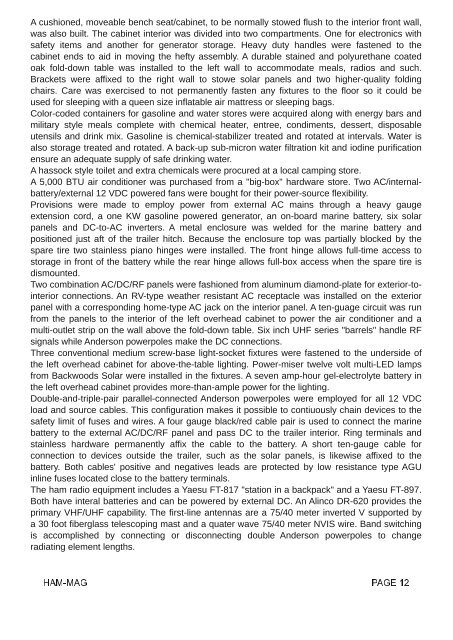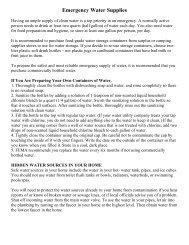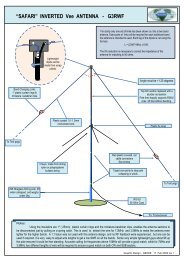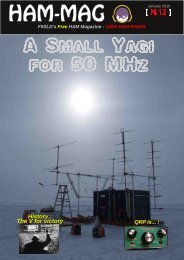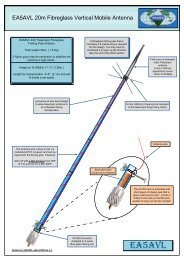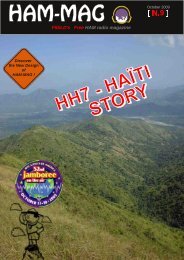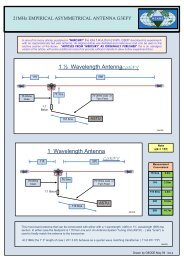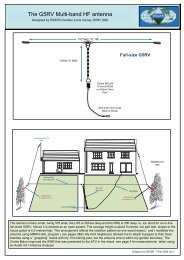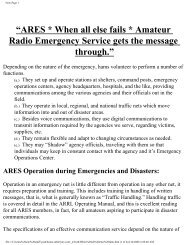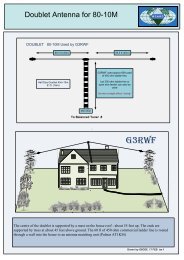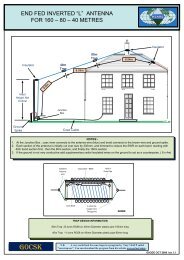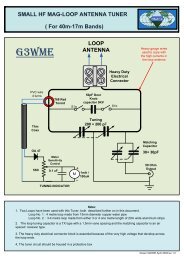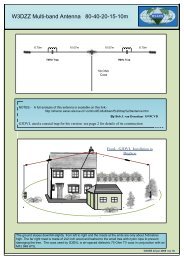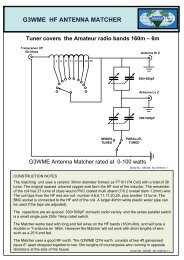HAM-MAG - arkansas ares races
HAM-MAG - arkansas ares races
HAM-MAG - arkansas ares races
You also want an ePaper? Increase the reach of your titles
YUMPU automatically turns print PDFs into web optimized ePapers that Google loves.
A cushioned, moveable bench seat/cabinet, to be normally stowed flush to the interior front wall,<br />
was also built. The cabinet interior was divided into two compartments. One for electronics with<br />
safety items and another for generator storage. Heavy duty handles were fastened to the<br />
cabinet ends to aid in moving the hefty assembly. A durable stained and polyurethane coated<br />
oak folddown table was installed to the left wall to accommodate meals, radios and such.<br />
Brackets were affixed to the right wall to stowe solar panels and two higherquality folding<br />
chairs. Care was exercised to not permanently fasten any fixtures to the floor so it could be<br />
used for sleeping with a queen size inflatable air mattress or sleeping bags.<br />
Colorcoded containers for gasoline and water stores were acquired along with energy bars and<br />
military style meals complete with chemical heater, entree, condiments, dessert, disposable<br />
utensils and drink mix. Gasoline is chemicalstabilizer treated and rotated at intervals. Water is<br />
also storage treated and rotated. A backup submicron water filtration kit and iodine purification<br />
ensure an adequate supply of safe drinking water.<br />
A hassock style toilet and extra chemicals were procured at a local camping store.<br />
A 5,000 BTU air conditioner was purchased from a "bigbox" hardware store. Two AC/internalbattery/external<br />
12 VDC powered fans were bought for their powersource flexibility.<br />
Provisions were made to employ power from external AC mains through a heavy gauge<br />
extension cord, a one KW gasoline powered generator, an onboard marine battery, six solar<br />
panels and DCtoAC inverters. A metal enclosure was welded for the marine battery and<br />
positioned just aft of the trailer hitch. Because the enclosure top was partially blocked by the<br />
spare tire two stainless piano hinges were installed. The front hinge allows fulltime access to<br />
storage in front of the battery while the rear hinge allows fullbox access when the spare tire is<br />
dismounted.<br />
Two combination AC/DC/RF panels were fashioned from aluminum diamondplate for exteriortointerior<br />
connections. An RVtype weather resistant AC receptacle was installed on the exterior<br />
panel with a corresponding hometype AC jack on the interior panel. A tenguage circuit was run<br />
from the panels to the interior of the left overhead cabinet to power the air conditioner and a<br />
multioutlet strip on the wall above the folddown table. Six inch UHF series "barrels" handle RF<br />
signals while Anderson powerpoles make the DC connections.<br />
Three conventional medium screwbase lightsocket fixtures were fastened to the underside of<br />
the left overhead cabinet for abovethetable lighting. Powermiser twelve volt multiLED lamps<br />
from Backwoods Solar were installed in the fixtures. A seven amphour gelelectrolyte battery in<br />
the left overhead cabinet provides morethanample power for the lighting.<br />
Doubleandtriplepair parallelconnected Anderson powerpoles were employed for all 12 VDC<br />
load and source cables. This configuration makes it possible to contiuously chain devices to the<br />
safety limit of fuses and wires. A four gauge black/red cable pair is used to connect the marine<br />
battery to the external AC/DC/RF panel and pass DC to the trailer interior. Ring terminals and<br />
stainless hardware permanently affix the cable to the battery. A short tengauge cable for<br />
connection to devices outside the trailer, such as the solar panels, is likewise affixed to the<br />
battery. Both cables' positive and negatives leads are protected by low resistance type AGU<br />
inline fuses located close to the battery terminals.<br />
The ham radio equipment includes a Yaesu FT817 "station in a backpack" and a Yaesu FT897.<br />
Both have interal batteries and can be powered by external DC. An Alinco DR620 provides the<br />
primary VHF/UHF capability. The firstline antennas are a 75/40 meter inverted V supported by<br />
a 30 foot fiberglass telescoping mast and a quater wave 75/40 meter NVIS wire. Band switching<br />
is accomplished by connecting or disconnecting double Anderson powerpoles to change<br />
radiating element lengths.


